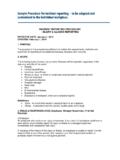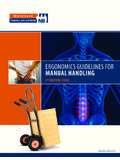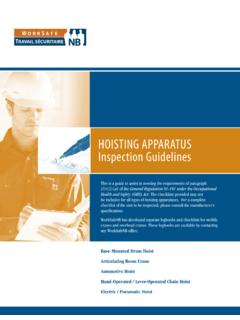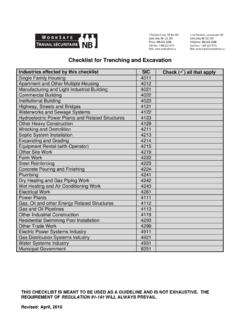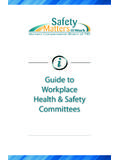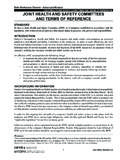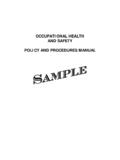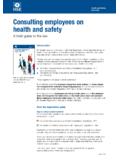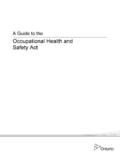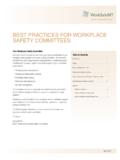Transcription of GUIDE TO WORKPLACE HEALTH & SAFETY …
1 GUIDE TO WORKPLACE HEALTH & SAFETY PROGRAMS2 GUIDE TO WORKPLACE HEALTH & SAFETY programs WorkSafeNBAdapted from the Workers Compensation Board of document, GUIDE to Occupational HEALTH and SAFETY June 2014 WorkSafeNB GUIDE TO WORKPLACE HEALTH & SAFETY programs 3 GUIDE TO WORKPLACE HEALTH & SAFETY PROGRAMSI ntroduction ..4 About this GUIDE ..4 What is a HEALTH and SAFETY Program? ..4 Legal Requirement ..4 Internal Responsibility System ..5 Who is Responsible for the Program? ..5 Getting Started ..6 General Responsibilities ..6 Building a HEALTH and SAFETY Program from the Ground Up ..7 programs and Due Diligence ..7 Legal Requirements ..8 Step 1: Create a SAFETY Policy ..9 Tips for Turning Your SAFETY Policy Into Action ..9 Step 2: Establish a joint HEALTH and SAFETY Committee or a HEALTH and SAFETY Representative ..10 The joint HEALTH and SAFETY Committee ..10 Role of JHSC and H&S Representatives in programs .
2 11 Other Duties ..11 Step 3: Establish and Record Regular WORKPLACE Inspections ..12 WORKPLACE Inspections ..12 Step 4: Incident Investigation ..14 Incident Investigation ..14 What About Near Misses? ..14 Step 5: Creating a Hazard Identification System ..15 What is a Hazard Identification System? ..15 Getting Started ..15 Identifying Potential Hazards ..15 Step 6: Develop Written Work Procedures ..17 Work Procedures ..17 Writing a Safe Work Procedure ..18 Work Procedures for Reporting Hazards ..18 What About Emergency Procedures? ..19 Step 7: Establish Orientation, Training and Supervision ..20 Orientation and Training ..20 Who Should Receive Orientation? ..21 When is Training Required? ..22 Is Specific Training Legislated? ..23 Supervision ..23 What if a Worker Refuses to Follow Safe Work Procedures? ..23 Step 8: Maintain Records and Statistics ..24 Records and Statistics ..24 Step 9: Monitoring the Program.
3 26 Appendix A. Draft Occupational HEALTH And SAFETY Policy ..27 Appendix B. Sample WORKPLACE Inspection Report Form ..28 Appendix C. Incident/Injury Investigation Report Form ..29 Appendix D. Sample Critical Hazard Identification System ..31 Resources for More Information ..344 GUIDE TO WORKPLACE HEALTH & SAFETY programs WorkSafeNBTHE WORKPLACE HEALTH & SAFETY PROGRAM:YOUR RECIPE FOR A HEALTHIER SAFER WORKPLACEINTRODUCTIONABOUT THIS GUIDEThis GUIDE is for employers, employees, joint HEALTH and SAFETY committees (JHSCs), and HEALTH and SAFETY (H&S) representatives. It will help you prepare and maintain your written HEALTH and SAFETY program. This GUIDE describes the elements of a formal HEALTH and SAFETY program, and the roles and responsibilities of those preparing and maintaining the program. It will also assist your WORKPLACE in complying with the requirements of the Occupational HEALTH and SAFETY (OHS) Act to develop and implement an effective HEALTH and SAFETY IS A HEALTH AND SAFETY PROGRAM?
4 To create a good SAFETY culture, you need a plan. A HEALTH and SAFETY program is an organized, written action plan to identify and control hazards, define SAFETY responsibilities and respond to emergencies that result in the prevention of accidents and occupational diseases. The objective of a program is to integrate SAFETY and HEALTH into all work practices and conditions. Having a safe work environment where prevention is a priority to an organization s success is important to all WORKPLACE parties employers, employees, supervisors and managers, and JHSC members and H&S representatives. A business that incorporates safe work practices into its daily work routine can realize savings in human and financial REQUIREMENTA HEALTH and SAFETY program is required under the OHS Act for provincially-regulated employers in New Brunswick with 20 or more employees regularly (1) Every employer with 20 or more employees regularly employed in the Province shall establish a written HEALTH and SAFETY program, in consultation with the committee or the HEALTH and SAFETY program requirement is tied to employers, not workplaces.
5 Therefore, employers must take into account all of their operations in the province of New Brunswick. If, for example, an employer has an operation in one location with 15 regularly employed employees and another five regularly employed employees in another location, the employer will be required to comply with the provisions of subsection 8(1) to establish a SAFETY policy and (1) for a and sub-contractors must have a program if they have 20 or more employees directly employed. Sub-contractors and their employees working for the contactors would not be counted in the GUIDE will help you comply with the HEALTH and SAFETY requirements for your WORKPLACE . It should be noted however that your HEALTH and SAFETY program may not address all HEALTH and SAFETY matters found in your WORKPLACE . A thorough review of the OHS Act and the regulations may be necessary to verify this fact. WorkSafeNB GUIDE TO WORKPLACE HEALTH & SAFETY programs 5 INTERNAL RESPONSIBILITY SYSTEMA HEALTH and SAFETY program promotes the internal responsibility system on which the OHS Act is based by requiring employers to consult with employees in the development, implementation and monitoring of the program.
6 Under the internal responsibility system, the people doing the work are responsible for creating a healthy and safe WORKPLACE . No matter where or who the person is within the organization, they can address SAFETY in a way that fits with what they do. Every person takes initiative to improve HEALTH and cannot reasonably monitor the SAFETY activities of each and every New Brunswick WORKPLACE ; therefore, employers and employees must work together together to develop the WORKPLACE HEALTH and SAFETY program and ultimately must take responsibility for their own SAFETY . WHO IS RESPONSIBLE FOR THE PROGRAM?Ultimately, the employer is responsible for developing, implementing and monitoring the HEALTH and SAFETY program. However the legislation requires consultation with employees before implementing the program. Consulting employees about HEALTH and SAFETY can result in many positive outcomes including:1. A healthier and safer Better decisions about HEALTH and A stronger commitment to implementing decisions or Greater co-operation and joint involves the employer not only giving information to employees but also listening to them and taking account of their views before making any final HEALTH and SAFETY decisions.
7 Consultation does not remove the employer s right to manage. They will still make the final decision. However, talking to employees is an important part of successfully managing HEALTH and SAFETY at the legislation requires that the JHSC or H&S representative be consulted on all matters pertaining to the HEALTH and SAFETY program. The JHSC (or H&S representative) is responsible for helping to monitor the program s effectiveness. Committee members are encouraged to contribute to the program s development by ensuring that the topic of HEALTH and SAFETY program monitoring and review becomes a standing item of the committee s business, or, in the case of H&S representatives, any other meetings that occur in the WORKPLACE that address HEALTH and SAFETY matters. SAFETY IS EVERYONE S RESPONSIBILITY!6 GUIDE TO WORKPLACE HEALTH & SAFETY programs WorkSafeNBGETTING STARTEDWHAT DOES AN EFFECTIVE HEALTH AND SAFETY PROGRAM LOOK LIKE?
8 GENERAL RESPONSIBILITIESE mployee and employer responsibilities will vary depending on the industry and nature of the work. However, across all industries and sectors, there are general responsibilities expected within a HEALTH and SAFETY program at all operational levels. These include but are not limited to:POSITION GENERAL RESPONSIBILITIESS enior Management/Leadership Establish and approve policy direction and planning. Monitor effectiveness of the program and take action as required. Delegate responsibility and authority. Allocate budget. Co-operate with SAFETY committees and representatives. Hold line managers accountable for safe production. Make sure line managers have adequate resources and support. Assist the JHSC or H&S representative. Respond promptly to recommendations from JHSC/H&S representatives.
9 Report incidents and injuries to Management (Supervisors) Provide training as required. Supervise employees to ensure safe work procedures are followed correctly. Communicate hazard information and control procedures. Consult with employees on HEALTH and SAFETY matters. Investigate incidents to identify root cause and corrective actions. Provide feedback to senior management. Co-operate with the JHSC or representative. Hold employees and other persons under their supervision accountable for HEALTH and SAFETY . Report incidents and injuries to Employees Comply with company rules and procedures. Wear personal protective equipment (PPE) as required. Use machinery, equipment, and materials only as authorized. Follow job procedures. Report hazards, unsafe conditions or actions to your supervisor.
10 Report incidents (near misses). Report all injuries to your employer/supervisor or other designated persons, no matter how minor. Co-operate with the JHSC or H&S GUIDE TO WORKPLACE HEALTH & SAFETY programs 7 joint HEALTH and SAFETY committees Hold monthly meetings; record, post, and send minutes to WorkSafeNB. Make recommendations on HEALTH and SAFETY issues. Carry out inspections, investigations, and direct employee SAFETY concerns as appropriate. Help develop the HEALTH and SAFETY program, the SAFETY policy, and safe work & SAFETY Representatives Make recommendations on HEALTH and SAFETY issues. Take employee HEALTH and SAFETY concerns to A HEALTH AND SAFETY PROGRAM FROM THE GROUND UPThere are many factors to consider when developing a HEALTH and SAFETY program for your WORKPLACE . This section describes the components of an effective programs START WITH MANAGEMENT a HEALTH and SAFETY program to be effective, there must be an obvious, solid commitment from top management.


![SAFETY TALK [hearing protection] - WorkSafeNB – …](/cache/preview/3/4/b/8/d/f/0/4/thumb-34b8df04d33dcf40e26b345789106441.jpg)
